The survey found the profile of a typical person participating in the arts sector is a female, aged 34.5 who lives in London, is highly educated with a minimum of a undergraduate degree, and probably a post-graduate degree.
She most likely works for a privately owned small business involved in the Performing Arts or Education, usually from an office in an Administration position as a Specialist or Manager. She earns on average £19,876.00 per annum and believes her earnings capacity will be the same this year as it was last year and will continue to be the same in 2014. She will tend to have more than one job but no more than two. The majority of her income will come from the arts industry and she is not supported financially by another person.
Her average job tenure is 3.75 years and has had 5 jobs in the past 10 years, all of which have been in the arts industry. Every week she works on average 36.5 hours. She is motivated not by money but by her passion for the arts and overall enjoys good job satisfaction.
Survey Analysis
Arts industry segmentation – by gender
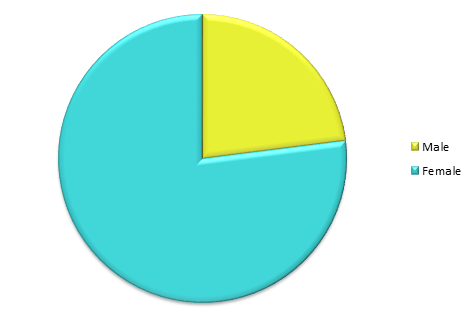
- 77% of arts industry workers are female (versus 47% of the workforce)
- 23% of arts industry workers are male (versus 53% of the workforce)
Arts industry segmentation – by age

- 52% of people who work in the UK Arts Industry are aged between 25–34 years of age, (versus general population of 13.6%)
- 19% are aged 35–44 year old, (versus general population of 14%)
- 10% are between 45-54 years of age (versus general population of 13.8%)
- 81% of people who work in the UK Arts Industry are aged between 25-54 years of age
- The average age of a person working in the arts industry is 34.5
Arts industry segmentation – by location
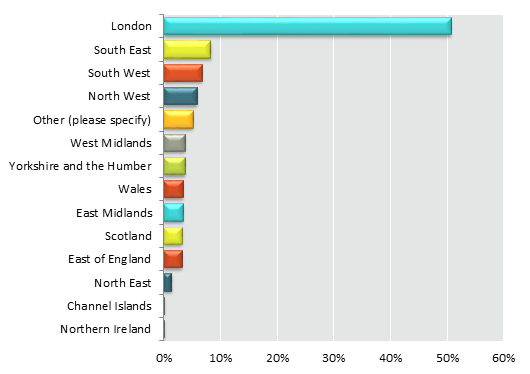
- Of those who work in the Arts Industry 51% reside in London (versus general population of 13%)
- Of those who work in the Arts Industry 86% reside in England
Arts industry segmentation – by highest qualification

- Almost 47.5% of the Arts Industry has an undergraduate degree as their highest qualification
- 42.9% have a graduate degree
- 90% of respondents have either an undergraduate or graduate or degree (versus 27% of the general UK population)
- 4.9% have graduated from secondary school as their highest qualification
- 4.5% have a professional certificate as their highest qualification
- Less than 1% has no qualifications at all (versus 23% of the general UK population)
Arts industry segmentation – by sector

- 9% work for government agencies
- 42% of the Arts Industry works for a not-for-profit organization
- 49% work for private business
Arts industry categories
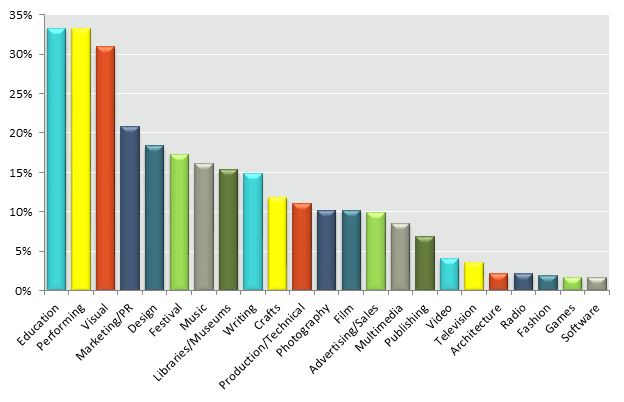
Working in Performing Arts and Education are the most common arts industry categories with 33% of all people respectively operating in those two areas, followed by Visual Art at 31% and Marketing/PR at 21%
- Working in Arts Software Development and Gaming are the least common with just under 2% of all arts industry people operating in those areas
Arts industry segmentation – by position type/job experience
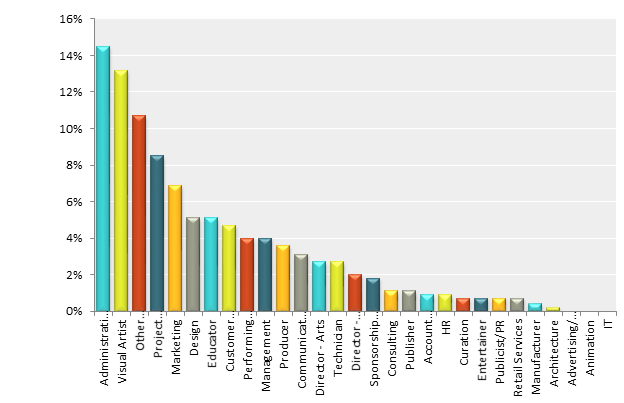
- The most common position type/job expertise in the arts industry is Administration with over 15% of respondents defining this as their position type/job expertise, followed by Visual Artist with 13% and ‘Other’ rounding out the top 3 with 11%
- Trending position types in ‘Other’ not included in the orginal selection list were Events, Photographer, Historian and Media
- Project Manager and Marketing position types also featured strongly with 9% and 7%
- Management related roles reflect 28% of all position types in the arts industry
- The least common position types/job expertise in the arts industry relate to IT, Advertising/Sales and Animation – with no one defining these as their position type/job expertise
Arts industry segmentation – by job position levels
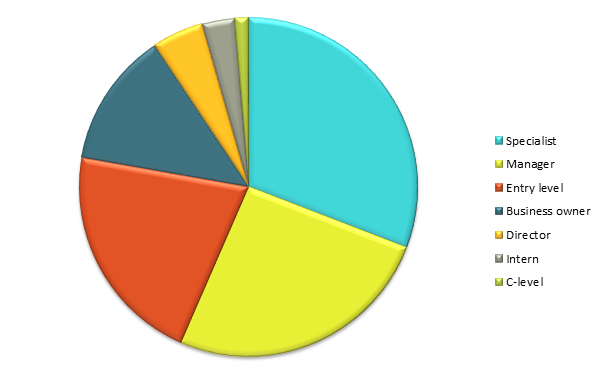
- 31% of all Arts Industry people are classified as ‘Specialist’
- 26% are classified as a Manager
- 21% are classified as entry level staff
- 13% are classified as business owners
Arts industry organisation size
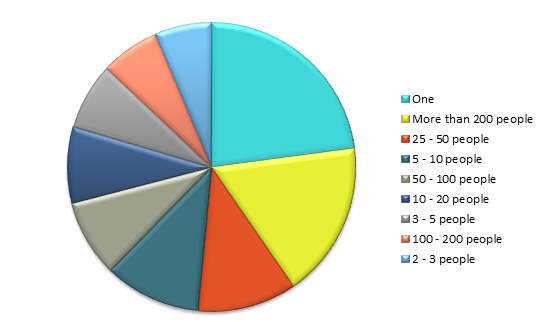
- 23% of arts industry businesses employ just 1 person
- 18% of arts industry businesses employ more than 200 people
- 11% of arts industry businesses employ between 25-50 people
- 18% of arts industry businesses are classified as large (200+)
- 26% of arts industry businesses are classified as medium (20–199)
- 56% of arts industry businesses are classified as small (1–19)
- The average organization size for the arts industry is 67
Estimated individual earnings
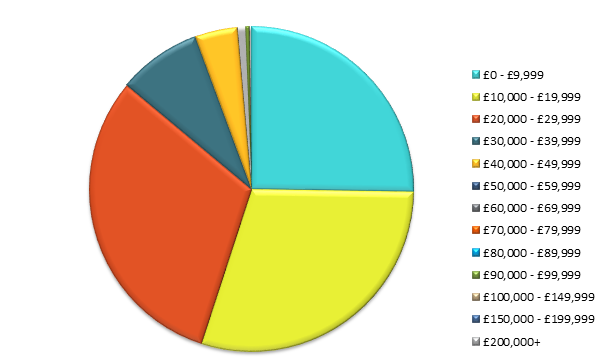
- 31% of arts industry people earn between £20,000–£29,999
- 30% of arts industry people earn between £10,000–£19,999
- 25% of arts industry people earn £0–£9,999
- Only 0.2% earn in excess of £200,000
- The average annual earnings for those working in arts industry is £19,876. This compares to average annual earnings of £26,884
- 14% of arts industry employees earn more than the average annual earnings
- 86% of arts industry employees earn less than the average annual earnings
- 86% of all arts industry people earn between £0–£29,999
- 2% earn more than £50,000 annually
- 98% earn less than £50,000 annually
Estimated individual earnings – this year versus last year
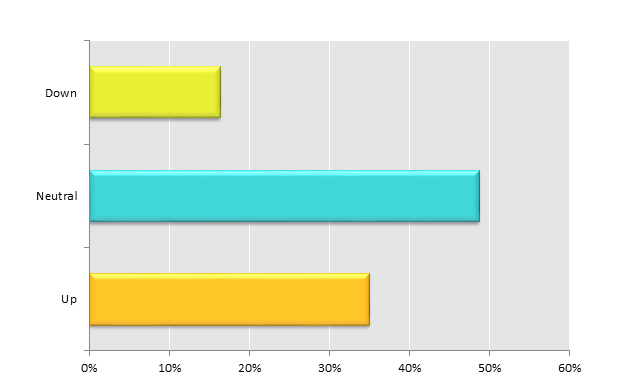
- Almost half of all people (49%) working in the arts estimate their individual earnings will be the same in 2013/2014 compared to last year
- 35% estimate their individual earnings will be up in 2013/2014 compared to last year
- 16% estimate their individual earnings will be down in 2013/2014 compared to last year
Estimated individual earnings growth – next year
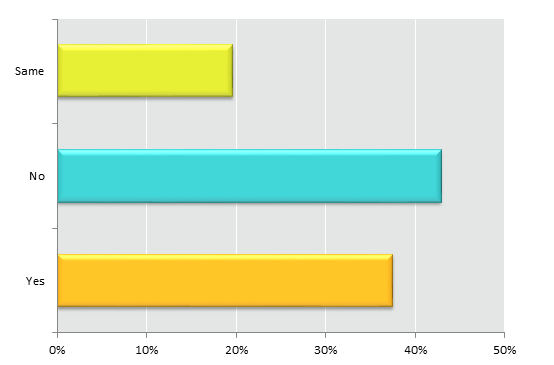
- 43% of all people working in the arts do not estimate their earnings will grow in 2014/2015
- 37% of all people working in the arts estimate their earnings will grow in 2014
- 20% of all people working in the arts estimate their earnings will remain the same
Number of arts industry sources of income

- 52% of arts industry people have 1 source of income (versus 96% of all working)
- 30% of arts industry people have 2 sources of income
- 11% of arts industry people have 3 sources of income
- 1% of arts industry people have 4 sources of income
- 6% of arts industry people have more than 4 sources of income
- 48% of arts industry people have more than 1 source of income (versus 4% of all working)
- The average number of arts industry income sources per person is 1.83
Proportion of income from arts industry activity

- 73% of people derive between 76%–100% of their income from the arts industry
- 14% of people derive between 0%–25% of their income from the arts industry
- 8% of people derive between 26%-50% of their income from the arts industry
- 5% of people derive between 51%–75% of their income from the arts industry
- The average proportion of individual income that comes from the arts is 72%
Arts industry – people financially supported by another person
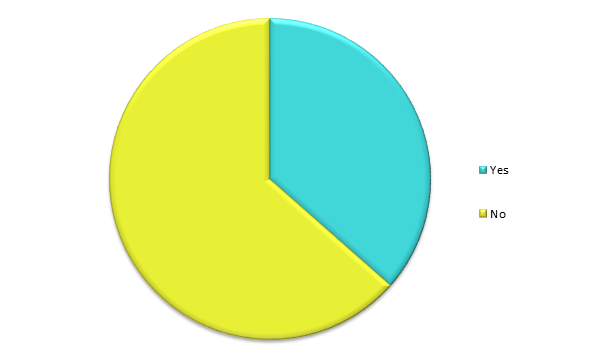
- 64% of arts industry people are not financially supported by another person
- 36% of arts industry people are financially supported by another person
Business reliance on funding
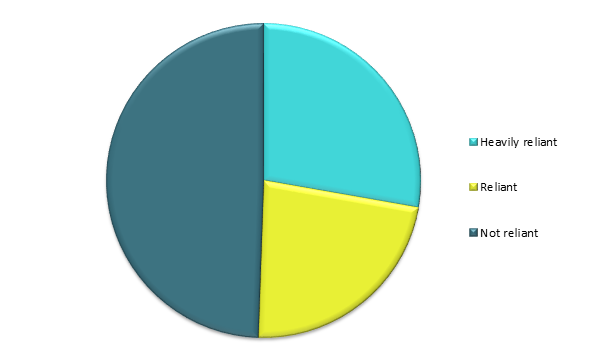
- 49% of all arts industry businesses are not reliant of funding
- 28% are heavily reliant on funding
- 23% are reliant on funding
- 51% are either reliant or heavily reliant on funding
Businesses receiving public and private funding

- 48.7% of arts industry businesses have received private funding in the past 5 years
- 51.3% of arts industry businesses have not received private funding in the past 5 years
- 49.5% of arts industry businesses have received public funding in the past 5 years
- 50.5% of arts industry businesses have not received public funding in the past 5 years
- When they have received public funding 30% of arts industry businesses have received in excess of $100,000 annually over the past 5 years
- When they have received private funding 19% of arts industry businesses have received in excess of $100,000 annually over the past 5 years
- The average amount of private funding arts businesses have received over the past 5 years is £60,442
- The average amount of public funding arts businesses have received over the past 5 years is £78,817
- On average arts industry businesses receive 30% more funding from the public sector versus the private sector
Average tenure in current job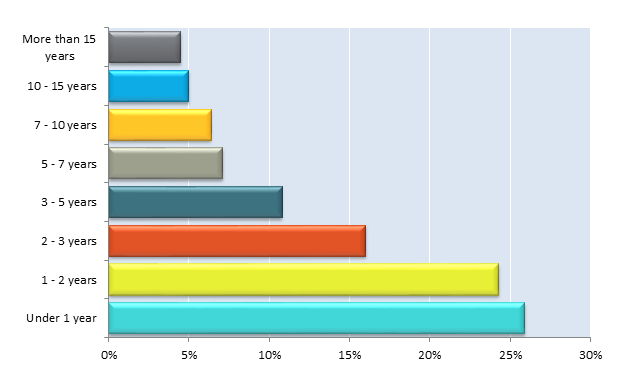
- 26% of arts industry employees have been in their current job for less than 1 year
- 24% have been in their current job between 1-2 years
- 5% of arts industry employees have been in their current job for more than 15 years
- 66% of arts industry employees have been in their current job for 3 years or less
- The average current job tenure for people employed in the arts industry is 3.75 years which is consistent with the average job tenure for all employed persons in the UK
Number of arts industry jobs held in the last 10 years

- 25% of all arts industry employees have had more than 7 arts related jobs in the last 10 years
- 38% of all arts industry employees have had between 1 and 3 arts related jobs in the last 10 years
- 50% of all arts industry employees have had more than 4 jobs in the last 10 years
- The average number of arts industry jobs held in the last 10 years is 5.04 years
Average arts industry tenure

- 14% of arts industry employees have worked in the arts industry for more than 15 years
- 40% of arts industry employees have worked in the arts industry for more than 7 years
- 4% of arts industry employees have worked in the arts industry for less than 1 year
- The average tenure in the arts industry is 7.27 years
Physical location of arts industry work

- 72% of arts industry people work from an office/studio
- 17% of arts industry people work from a home studio/office
- 11% of art industry people work from home (versus of 13% of all UK people working)
- 89% of arts industry people work from some kind of Office
Arts industry – average weekly hours of work
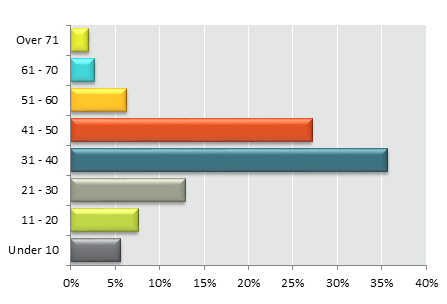
- 36% of all people employed in the arts industry work on average between 31–40 hours per week
- 27% of all people employed in the arts industry work on average between 41–50 hours per week
- The average weekly hours per week of all people employed in the arts industry is 36.57 hours
- This compares to the national average of 32.1 hours per week
- 38% of all people employed in the arts industry work longer hours than the national average of 32.1 hours
- 26% of all people employed in the arts industry work less hours than the national average
Arts industry – key career drivers

- 81% of people working in the arts say that passion is their key career driver
- 14% of people working in the arts are driven by lifestyle
- Only 5% of people working in the arts are driven by money
Arts industry – job satisfaction ratings

- 52% of the arts industry rated their job satisfaction as good
- 22% rated their job satisfaction as average
- 16% rated their job satisfaction as excellent
- 8% rated their job satisfaction as low
- 1.4% rated their job satisfaction as non-existent
- The overall average arts industry job satisfaction is good
Respondents’ thoughts on their future within the arts industry
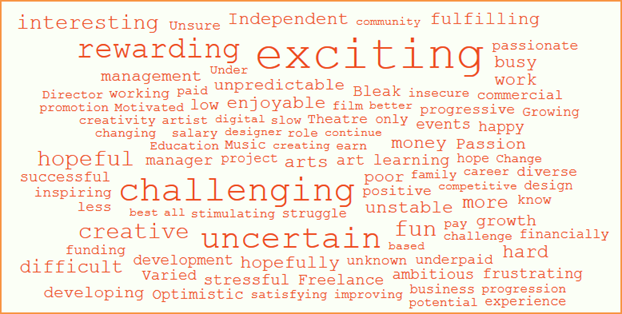
- 13% of people described their future in the arts as exciting
- 10% of people described their future in the arts as challenging
- 8% of people described their future in the arts as uncertain
About ArtsHub
ArtsHub is a leading online portal for the arts industry and for anyone who enjoys theatre, music, visual arts, literature or cultural life.
We provide information and entertainment on every aspect of the arts from previews, features and reviews for audiences to jobs, news and policy analysis for professionals.
Founded in 2000, ArtsHub has grown from an industry job site to Australia’s leading arts website. We enjoy a strong and growing subscriber base, which depends on ArtsHub, often accessing us daily to stay tuned in to the arts.
Our editorial coverage is broad and comprehensive, augmented by hundreds of contributors who cover the arts from all around Australia.
For job-seekers and job advertisers in the industry, ArtsHub is their exclusive arts portal. All subscribers receive ArtsHub’s weekly News, What’s On and Jobs bulletins, as well as our popular industry Special Reports and Festival Focus bulletins.
With a strong understanding of the arts industry and its policies, ArtsHub has come to realise the need of arts professionals, for specialist hubs and tailored opportunity, to find audience and art-buyers. At the same time the public needs a portable user-friendly solution to access information anywhere, anytime; about what’s on and what’s interesting beyond the limits of movie listings and gig guides.
A significant expansion in 2013 means ArtsHub is now a cutting-edge cross-platform website accessible on wide range of devices including mobile, tablet and desktop. It now includes a specialist Visual ArtsHub, a tailored Performing ArtsHub and a comprehensive what’s on and Jobs search facility for everyone.





